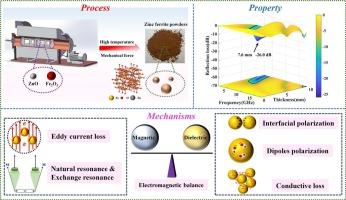A facile high-temperature mechanochemical preparation of zinc ferrite powder for microwave absorption
IF 4.6
3区 材料科学
Q2 MATERIALS SCIENCE, MULTIDISCIPLINARY
引用次数: 0
Abstract
Microwave absorbing materials (MAMs) of the ferrite type are crucial for resisting electromagnetic radiation. This work proposed a novel high-temperature mechanochemical method (HTMC) to prepare zinc ferrite (ZnFe2O4). The effects of key process parameters on the microstructure and properties of ZnFe2O4 were investigated. The results indicate that the electromagnetic and microwave absorption (MA) performances can be influenced by the crystallization and dispersion degree of ZnFe2O4. Meanwhile, its MA originates from the good synergy between its dielectric losses (dipole polarization, interfacial polarization, conductive loss) and magnetic losses (eddy current loss, natural resonance, exchange resonance). The HTMC achieves the coupling effect of mechanical force and high-temperature, refining particles while promoting the reaction process. It not only effectively optimizes reaction conditions and shortens the reaction process, but also enables large-scale preparation. This work enriches the existing strategies for the preparation of high-performance ferrite-type MAMs and provides promising insight for engineering applications.

微波吸收铁氧锌粉的高温机械化学制备
铁氧体型吸波材料是抵抗电磁辐射的重要材料。提出了一种高温机械化学法制备铁酸锌(ZnFe2O4)的新方法。研究了关键工艺参数对ZnFe2O4显微组织和性能的影响。结果表明,ZnFe2O4的结晶和分散程度会影响材料的电磁和微波吸收性能。同时,其MA来源于介电损耗(偶极极化、界面极化、导电损耗)与磁损耗(涡流损耗、自然共振、交换共振)之间的良好协同。HTMC实现了机械力与高温的耦合效应,在促进反应过程的同时细化了颗粒。不仅有效地优化了反应条件,缩短了反应过程,而且使大规模制备成为可能。这项工作丰富了现有的高性能铁氧体型MAMs的制备策略,并为工程应用提供了有希望的见解。
本文章由计算机程序翻译,如有差异,请以英文原文为准。
求助全文
约1分钟内获得全文
求助全文
来源期刊

Materials Science and Engineering: B
工程技术-材料科学:综合
CiteScore
5.60
自引率
2.80%
发文量
481
审稿时长
3.5 months
期刊介绍:
The journal provides an international medium for the publication of theoretical and experimental studies and reviews related to the electronic, electrochemical, ionic, magnetic, optical, and biosensing properties of solid state materials in bulk, thin film and particulate forms. Papers dealing with synthesis, processing, characterization, structure, physical properties and computational aspects of nano-crystalline, crystalline, amorphous and glassy forms of ceramics, semiconductors, layered insertion compounds, low-dimensional compounds and systems, fast-ion conductors, polymers and dielectrics are viewed as suitable for publication. Articles focused on nano-structured aspects of these advanced solid-state materials will also be considered suitable.
 求助内容:
求助内容: 应助结果提醒方式:
应助结果提醒方式:


